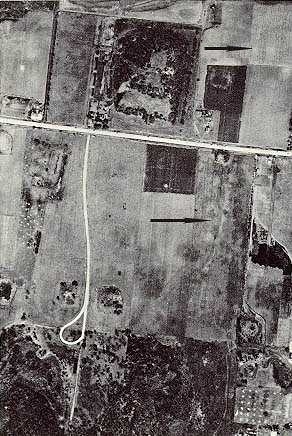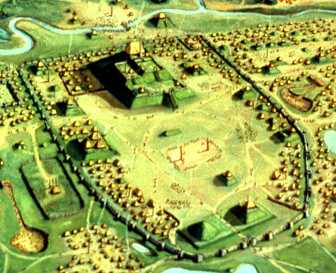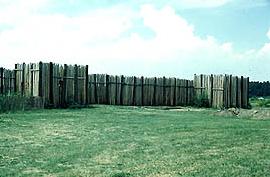 1933 Dache Reeves aerial photo of central Cahokia, arrows point to light
lines of ancient palisades. Excavations in 1998 confirm the existence of
a corresponding palisade wall on the wester side of central Cahokia.
1933 Dache Reeves aerial photo of central Cahokia, arrows point to light
lines of ancient palisades. Excavations in 1998 confirm the existence of
a corresponding palisade wall on the wester side of central Cahokia.
|
After discovering fortifications at the northern Mississippian town of Aztalan,
S.A. Barret suggested in the early 1930's the presence of some sort of wall
encircling the center of Cahokia. Aerial photographs taken by Dache Reeves soon
thereafter confirmed their existence. Since that time fortifications have been
discovered at numerous large Mississippian mound center settlements throughout
the southeastern United States including Larson and Orendorf in the Illinois
River Valley. In the American Bottom fortifications are known from Mitchell,
East St. Louis, and Olin.
 Artist's view of downtown Cahokia enclosed by a
wall with regularly-spaced bastions.
Artist's view of downtown Cahokia enclosed by a
wall with regularly-spaced bastions.
|
 1933 Dache Reeves aerial photo of central Cahokia, arrows point to light
lines of ancient palisades. Excavations in 1998 confirm the existence of
a corresponding palisade wall on the wester side of central Cahokia.
1933 Dache Reeves aerial photo of central Cahokia, arrows point to light
lines of ancient palisades. Excavations in 1998 confirm the existence of
a corresponding palisade wall on the wester side of central Cahokia.
 Artist's view of downtown Cahokia enclosed by a
wall with regularly-spaced bastions.
Artist's view of downtown Cahokia enclosed by a
wall with regularly-spaced bastions.
